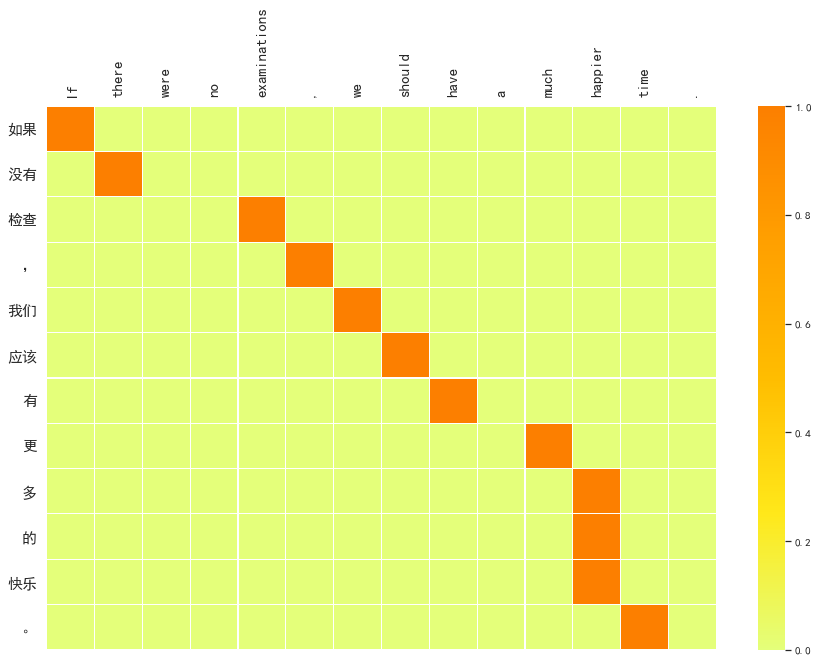Neural Machine Translation
Pytorch implementation of Neural Machine Translation with seq2seq and attention (en-zh) (英汉翻译)
This repo reaches 10.44 BLEU score in my test dataset.(Use multi-bleu.perl).
Introduction
The goal of machine translation is to maximize p(y|x). Due to the infinite space of language, directly estimating this conditional probability is impossible. Thus neural networks, which are good at fitting complex functions, are introduced into machine translation.
Sutskever et. al 2014 proposed a model consisting of encoder and decoder, named seq2seq. Once proposed, it set off a tornado in NMT. A number of follow-up work began (e.g. Cho et. al). One of the most famous work is the attention mechanism (Bahdanau et. al 2014).
In this repo, I implemented the seq2seq model with attention in PyTorch for en-zh translation.
Requirements
python 3.6
- PyTorch>=0.4
- torchtext
- nltk
- jieba
- subword-nmt
Usage
First, run
./preprocess.shto tokenize and do BPE.
Then run nmt.ipynb for training and testing.
Lastly, BLEU score is calculated by
perl multi-bleu.perl references.txt < predictions.txt
Pretrained model can be found here. (passwd:ukvh)
Data
neu2017 from CWMT corpus 2017
2 million parallel sentences (enzh)
98% of data is for training, the other for validating and testing.
Preprocessing
- tokenizer
- zh: jieba
- en: nltk.word_tokenizer
- BPE: subword-nmt (For the parameter
num_operations, I choose 32000.)
It is worth mentioning that BPE reduced the vocabulary significantly, from 50000+ to 32115.
Besides, <sos> and <eos> symbols are conventionally prepended to each sentences. OOV is represented with <unk>.
One problem in my training is that the vocabulary of Chinese is so large that I only took those the top 50k most frequent, which results in many <unk> in my training dataset. Too many <unk> in many training dataset has bad influence in my model when training. My model prefers to predict <unk> as well. So I just ignore <unk> when predicting.
Model Architecture (seq2seq)
Similar to Luong et. al 2015.
- embeddings: glove (en)& word2vec (zh) (both 300-dim)
- encoder: 4-layer Bi-GRU (hidden-size 1000-dim)
- decoder: 4-layer GRU with attention (hidden-size 1000-dim)
- attention: bilinear global attention
According to Chung, J. et. al 2014, GRU can reach similar performance as LSTM. So I chose GRU.
Training details
Hypter-Params:
- optim: Adam
- lr: 1e-4
- no L2 regularization (Since there is no obvious overfitting)
- dropout: 0.3
- clip gradient norm: 0.5
- warm-up: fix embeddings before 1 epoch
validation loss:
 (The periodic bulge is because I reset optimizer every epoch. It is not necessary.)
(The periodic bulge is because I reset optimizer every epoch. It is not necessary.)
Perplexity reaches 5.5 in validation dataset.
Trained 231K steps, nearly 4 epochs
I found that training is a bit slow. However, some parameters including attention parameters can not be tuned well with larger learning rate.
Beam Search
According to wikipedia, beam search is BFS with width constraints.
Google's GNMT paper gave two refinements to the beam search algorithm: a coverage penalty and length normalization. The coverage penalty formula they proposed is so empirical that I just use length normalization. But I found that this method did not perform very well. I got 9.23 BLEU which is less than 10.44 which normal beam search algorithm reached.
Visualization
Alignment visualizations:
References
-
Sutskever, I., Vinyals, O. and Le, Q.V., 2014. Sequence to sequence learning with neural networks. In Proceedings of NIPS 2014. (Citation: 5,780)
-
Cho, K., Van Merriënboer, B., Gulcehre, C., Bahdanau, D., Bougares, F., Schwenk, H. and Bengio, Y., 2014. Learning phrase representations using RNN encoder-decoder for statistical machine translation. In Proceedings of EMNLP 2014. (Citation: 4,411)
-
Bahdanau, D., Cho, K. and Bengio, Y., 2014. Neural machine translation by jointly learning to align and translate. In Proceedings of ICLR 2015. (Citation: 5,933)
-
Luong, M.T., Pham, H. and Manning, C.D., 2015. Effective approaches to attention-based neural machine translation. In Proceedings of EMNLP 2015. (Citation: 1,550)
-
Wu, Y., Schuster, M., Chen, Z., Le, Q.V., Norouzi, M., Macherey, W., Krikun, M., Cao, Y., Gao, Q., Macherey, K. and Klingner, J., 2016. Google's neural machine translation system: Bridging the gap between human and machine translation. In Proceedings of NIPS 2016. (Citation: 1,046)
-
Sennrich, R., Haddow, B. and Birch, A., 2015. Neural machine translation of rare words with subword units. In Proceedings of ACL 2016. (Citation: 789)
-
Press, O. and Wolf, L., 2016. Using the output embedding to improve language models. In Proceedings of EACL 2017. (Citation: 139)
-
Zhou, J., Cao, Y., Wang, X., Li, P. and Xu, W., 2016. Deep recurrent models with fast-forward connections for neural machine translation. In Proceedings of TACL 2016. (Citation: 75)
-
Chung, J., Gulcehre, C., Cho, K. and Bengio, Y., 2014. Empirical evaluation of gated recurrent neural networks on sequence modeling. In Proceedings of NIPS 2014. (Citation: 2,197)



